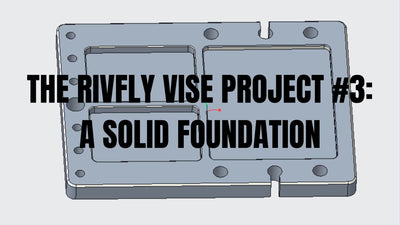Beyond Sight: How Sound and Vibration Can Revolutionize Your Fly Fishing
As fly anglers, we're obsessed with sight. We "match the hatch" based on color and size. We watch our dry fly intently for the slightest sip. But what happens when the fish aren't looking? What about when the water is murky, the light is low, or the surface is choppy?
On those days, the secret to success isn't showing the fish a better-looking meal; it's about ringing the dinner bell.
The Fish's Sixth Sense: Understanding the Lateral Line

Fish don't just hunt with their eyes. They have an incredible sensory organ called the lateral line. Think of it as a biological sonar system—a series of pores and nerve endings running along the fish's body that detects movement, pressure changes, and low-frequency vibrations in the water.
This is how a predator can feel a struggling baitfish from a distance, even in total darkness. It’s a primal sense tied directly to the instinct to feed. By only appealing to a fish's sight, we're often ignoring the most powerful trigger of all. For a deeper scientific dive, publications like Wiki offer excellent explanations of this amazing biological tool.
Making Noise on Purpose: Enter the Propeller Fly

So, how do we, as fly anglers, tap into this "sixth sense"? We need a fly that does more than just look the part. It needs to create a disturbance.
This is precisely why we developed the RIVFLY Propeller Disturbance Fly. It’s a hybrid marvel, engineered to be a multi-sensory assault on a predator's instincts. Here’s how it works:
- Vibration & Sound: As you retrieve the fly, the small propeller at the front spins, creating a distinct, low-frequency "thump" and vibration in the water. This is the "dinner bell" that the lateral line is designed to detect.
- Flash: The spinning blade throws off flashes of light, mimicking the panicked glint of a fleeing baitfish. It's a powerful visual trigger that works in tandem with the sound.
- Turbulence: The propeller creates a bubble trail and a pocket of turbulence, signaling a living, moving creature—an easy meal.
It’s not just a fly; it’s a beacon designed to call fish in and provoke an attack.
When Should You Ring the Dinner Bell?
This fly isn't for every situation, but when it's right, it's unbeatable. Think of it as your special weapon for when things get tough. Tie on a Propeller Disturbance Fly when you face:
- Murky or Stained Water: When visibility is low, fish rely almost entirely on their lateral line to hunt. A noisy fly is your best bet.
- Windy, Choppy Conditions: The surface chop that makes it hard to see your dry fly also masks your fly's presence. The propeller cuts through that noise, announcing its arrival.
- Targeting Aggressive Predators: Species like bass, pike, and even large, aggressive trout are hardwired to attack noisy, disruptive prey.
- When Nothing Else Works: If the fish are lethargic or ignoring your subtle patterns, a little commotion can be the wake-up call they need to start feeding.
How to Fish It: Simple Tips for Maximum Commotion
There's no complex technique here. The goal is to make that propeller spin.
- The Steady Retrieve: Cast out and retrieve at a steady pace, just fast enough to feel the propeller "thumping" through your line.
- The Strip-and-Pause: Use short, sharp strips to get the blade spinning, then pause. The fly will dip and flutter on the pause, often triggering a strike from a following fish.
- The Swing: In a river, you can cast across the current and let the fly swing down. The water pressure alone is often enough to spin the propeller, making it a deadly tactic for river bass and trout.
Conclusion: Add a New Sense to Your Arsenal
Fly fishing is a game of adaptation. By understanding that fish hunt with more than just their eyes, we open up a whole new world of possibilities. The Propeller Disturbance Fly is more than just a novelty; it's a tool built on the science of predatory behavior.
Next time you're faced with tough conditions, don't just change your fly's color—change the very sense you're appealing to. Make some noise.
Tight lines,
The RIVFLY Team
-----------------------------------------------------
Frequently Asked Questions (FAQ)
Q: Can I use the Propeller Disturbance Fly for trout?
A: Absolutely! While it's a superstar for bass, large, predatory brown and rainbow trout will aggressively attack it, especially in faster, more broken water.
Q: Does this fly require a special leader or line?
A: Not at all. You can use your standard streamer fishing setup. A 6 or 7-weight rod with a standard tapered leader is perfect.
Q: What makes this different from a conventional spinner lure?
A: It combines the best of both worlds. It has the lightweight profile, natural materials, and subtle action of a fly, making it fishable on a fly rod, but with the added attraction of a spinner's blade.




